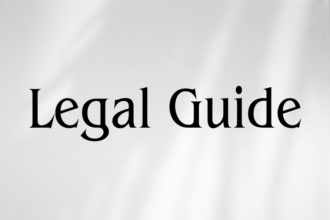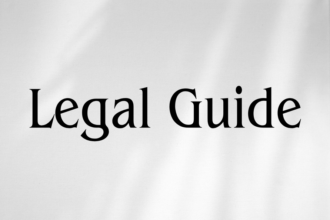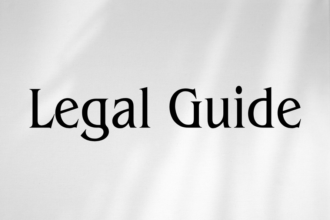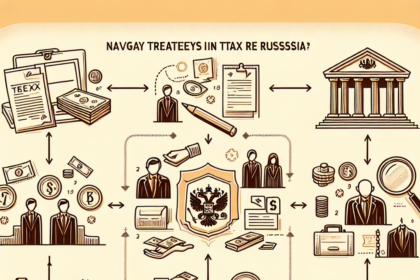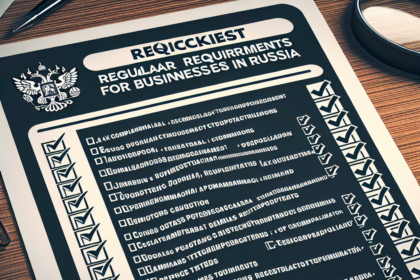Tag: Overview of Business Law in Russia
Introduction
Business law in Russia is a broad and intricate field that encompasses various legal practices involved in the regulation, formation, and operation of businesses within the country. This legal framework aims to ensure a fair, competitive, and transparent business environment while protecting the rights of consumers, employees, and other stakeholders. This comprehensive guide provides an in-depth overview of business law in Russia, covering key aspects such as legal structures, regulatory requirements, contracts, intellectual property, employment law, and more. By understanding these areas, businesses can ensure compliance and successful operations within the Russian legal landscape.
Chapter 1: Legal Structures in Russia
1.1 Types of Business Entities
Sole Proprietorship (Individual Entrepreneur)
- Overview: A business owned and operated by a single individual.
- Legal Requirements: Simple registration process with the Federal Tax Service.
- Advantages: Easy to set up and operate; full control by the owner; profits go directly to the owner.
- Disadvantages: Unlimited personal liability; limited ability to raise capital; business ceases upon the owner’s death.
General Partnership
- Overview: A business owned by two or more individuals sharing profits, losses, and management responsibilities.
- Legal Requirements: Registration with the Federal Tax Service; partnership agreement is highly recommended.
- Advantages: Shared resources and expertise; relatively simple to establish.
- Disadvantages: Unlimited liability for all partners; potential for conflicts among partners; profits must be shared.
Limited Partnership
- Overview: A partnership with both general and limited partners.
- Legal Requirements: Registration with the Federal Tax Service; detailed partnership agreement.
- Advantages: Limited partners have limited liability; general partners manage the business.
- Disadvantages: Unlimited liability for general partners; limited partners cannot participate in management without risking their limited liability status.
Limited Liability Company (LLC)
- Overview: A separate legal entity offering limited liability to its shareholders.
- Legal Requirements: Registration with the Federal Tax Service; minimum of one shareholder; articles of association.
- Advantages: Limited liability; flexibility in management; relatively simple to set up.
- Disadvantages: Restrictions on transferring shares; compliance with corporate governance standards.
Joint Stock Company (JSC)
- Overview: A corporate entity suitable for larger enterprises with the potential to go public.
- Types: Open Joint Stock Company (OJSC, shares traded publicly), Closed Joint Stock Company (CJSC, shares not publicly traded).
- Legal Requirements: Registration with the Federal Tax Service; minimum share capital; at least two shareholders; board of directors.
- Advantages: Limited liability; ability to raise capital through public offerings (OJSC); perpetual existence.
- Disadvantages: Extensive regulatory requirements; higher setup and operational costs.
1.2 Choosing the Right Business Structure
- Factors to Consider: Liability, tax implications, ease of setup, control, and ability to raise capital.
- Professional Advice: Seek legal and financial advice to determine the most suitable structure for your business.
Chapter 2: Regulatory Requirements
2.1 Business Registration
- Federal Tax Service (FTS): All businesses must register with the FTS to obtain a state registration number and taxpayer identification number (TIN).
- Unified State Register of Legal Entities (USRLE): Registration with the USRLE is mandatory for all legal entities.
2.2 Licensing and Permits
- Industry-Specific Requirements: Certain industries require specific licenses or permits (e.g., healthcare, construction).
- Municipal Requirements: Local permits may be required for operating a business in a specific location.
2.3 Taxation
Corporate Income Tax
- Overview: Administered by the Federal Tax Service; the standard rate is 20%.
- Compliance: Regular filing of tax returns and payment of taxes.
Value Added Tax (VAT)
- Registration: Required for businesses with annual revenue exceeding a certain threshold.
- Compliance: Regular filing and remittance of VAT to the Federal Tax Service.
2.4 Employment Standards
- Labor Code: Compliance with the Labor Code, including minimum wage, working hours, and employee rights.
- Social Insurance Contributions: Mandatory social insurance contributions for employees.
2.5 Health and Safety
- Occupational Health and Safety: Employers must ensure a safe working environment and comply with relevant health and safety regulations.
- Workplace Inspections: Regular inspections by labor inspectors to ensure compliance.
2.6 Privacy and Data Protection
- Federal Law on Personal Data: Compliance with laws governing the handling of personal data.
- Roskomnadzor: Registration with Roskomnadzor for certain data processing activities.
Chapter 3: Contracts and Agreements
3.1 Elements of a Valid Contract
- Offer and Acceptance: Clear offer by one party and acceptance by the other.
- Consideration: Something of value exchanged between the parties.
- Intention to Create Legal Relations: Both parties must intend to enter into a legally binding agreement.
- Capacity: Parties must have the legal capacity to contract.
- Legality: The contract must be for a legal purpose.
3.2 Types of Business Contracts
Employment Contracts
- Contents: Job description, salary, benefits, termination conditions.
- Compliance: Must adhere to labor law regulations.
Sales and Purchase Agreements
- Contents: Description of goods/services, price, delivery terms, warranties.
Lease Agreements
- Contents: Terms of property rental, responsibilities of landlord and tenant.
Partnership Agreements
- Contents: Roles and responsibilities of partners, profit-sharing, dispute resolution.
Non-Disclosure Agreements (NDAs)
- Purpose: Protect confidential information shared between parties.
3.3 Contract Enforcement and Dispute Resolution
- Breach of Contract: Legal remedies available for breach, including damages, specific performance, and rescission.
- Alternative Dispute Resolution (ADR): Mediation and arbitration as alternatives to litigation.
Chapter 4: Intellectual Property (IP)
4.1 Types of Intellectual Property
Trademarks
- Purpose: Protects brand names, logos, and other distinctive signs.
- Registration: Must register with the Federal Service for Intellectual Property (Rospatent).
Patents
- Purpose: Protects new inventions and processes.
- Registration: Requires a detailed application and examination process with Rospatent.
Copyrights
- Purpose: Protects original literary, artistic, musical, and other creative works.
- Automatic Protection: No registration required, but registration provides additional legal benefits.
Industrial Designs
- Purpose: Protects the visual design of products.
- Registration: Must register with Rospatent.
Trade Secrets
- Purpose: Protects confidential business information.
- Protection: No formal registration; relies on confidentiality agreements and internal security measures.
4.2 Managing Intellectual Property
- Licensing: Granting permission to use IP rights in exchange for royalties.
- Enforcement: Legal actions to protect IP rights from infringement.
4.3 International Considerations
- International Treaties: Russia is a member of several international IP treaties, including the Paris Convention and the Patent Cooperation Treaty (PCT).
- Global Protection: Strategies for protecting IP rights in multiple jurisdictions.
Chapter 5: Employment Law
5.1 Employment Standards
Minimum Wage
- Overview: Set by the government; employers must pay at least the minimum wage.
Working Hours
- Standard Hours: Typically 40 hours per week; overtime pay required for additional hours.
Leave Entitlements
- Annual Leave: Paid vacation entitlements based on length of service.
- Sick Leave: Paid or unpaid leave for illness or medical appointments.
- Maternity and Parental Leave: Entitlements for new parents.
5.2 Workplace Rights
Non-Discrimination
- Overview: Laws prohibiting discrimination based on race, gender, age, disability, and other protected characteristics.
Health and Safety
- Employer Responsibilities: Ensuring a safe workplace and compliance with occupational health and safety regulations.
5.3 Termination of Employment
Grounds for Termination
- Performance: Poor performance or misconduct.
- Redundancy: Economic reasons or business restructuring.
- Constructive Dismissal: When an employer changes the employment terms to the detriment of the employee, forcing resignation.
Notice Period
- Requirement: Notice period must be given based on length of service and employment contract terms.
Severance Pay
- Entitlement: Payment based on length of service and reason for termination.
Chapter 6: Corporate Governance
6.1 Board of Directors
Role and Responsibilities
- Strategic Direction: Setting the overall strategy and direction of the company.
- Fiduciary Duty: Acting in the best interests of the company and its shareholders.
6.2 Shareholder Rights
Voting Rights
- Participation: Shareholders have the right to vote on major corporate decisions.
- Annual General Meeting (AGM): Shareholders can attend and vote at the AGM.
Dividends
- Entitlement: Shareholders have the right to receive dividends from company profits.
Chapter 7: Competition and Consumer Protection
7.1 Competition Law
Overview
- Purpose: Promote fair competition and prevent anti-competitive practices.
- Key Legislation: Federal Law No. 135-FZ on Protection of Competition.
Prohibited Practices
- Cartels: Agreements between competitors to fix prices, limit production, or divide markets.
- Abuse of Dominance: Conduct by dominant firms to exclude competitors or control markets.
Enforcement
- Federal Antimonopoly Service (FAS): Federal agency responsible for enforcing competition law.
7.2 Consumer Protection
Key Legislation
- Consumer Protection Law: Protects consumers from unfair business practices.
Rights and Remedies
- Product Safety: Regulations ensuring the safety of consumer products.
- False Advertising: Prohibitions on misleading or deceptive advertising.
- Remedies: Refunds, repairs, or replacements for defective products.
Chapter 8: Environmental Law and Corporate Responsibility
8.1 Environmental Regulations
Key Legislation
- Federal Law on Environmental Protection: Governs environmental protection and sustainable development.
Compliance
- Environmental Assessments: Required for certain projects to evaluate potential environmental impacts.
- Pollution Control: Regulations on emissions, waste disposal, and hazardous substances.
8.2 Corporate Social Responsibility (CSR)
Overview
- Importance: Increasing focus on ethical business practices and sustainability.
- CSR Strategies: Initiatives to reduce environmental impact, improve community relations, and promote social good.
Reporting
- Sustainability Reports: Voluntary or mandatory reporting on CSR activities and performance.
Chapter 9: International Trade and Business Law
9.1 Trade Agreements
Key Agreements
- Eurasian Economic Union (EAEU): Trade agreement with several former Soviet states.
- Bilateral Agreements: Trade agreements with individual countries.
Benefits
- Tariff Reductions: Lower tariffs on goods and services.
- Market Access: Improved access to international markets.
9.2 Import and Export Regulations
Customs Requirements
- Documentation: Necessary paperwork for importing and exporting goods.
- Duties and Taxes: Payment of applicable duties and taxes.
Compliance
- Trade Controls: Regulations on the export of certain goods and technologies.
- Sanctions: Compliance with international sanctions and embargoes.
Conclusion
Business law in Russia is a complex and multifaceted field that encompasses a wide range of legal practices and regulatory requirements. This comprehensive guide has provided an in-depth overview of key aspects such as legal structures, regulatory requirements, contracts, intellectual property, employment law, and more. By understanding these areas, businesses can ensure compliance and successful operations within the Russian legal landscape.
FAQs
- What are the main types of business structures in Russia?
- The main types include sole proprietorships, general partnerships, limited partnerships, limited liability companies (LLCs), and joint stock companies (JSCs).
- What are the key regulatory requirements for starting a business in Russia?
- Key requirements include business registration, licensing and permits, taxation, employment standards, health and safety regulations, and data protection compliance.
- How does Russia protect intellectual property rights?
- Russia protects intellectual property through trademarks, patents, copyrights, industrial designs, and trade secrets, with registration and enforcement managed by the Federal Service for Intellectual Property (Rospatent).
- What are the employment standards in Russia?
- Employment standards include minimum wage, working hours, leave entitlements, workplace rights, health and safety regulations, and termination conditions.
- How does competition and consumer protection law work in Russia?
- Competition law promotes fair competition and prevents anti-competitive practices, enforced by the Federal Antimonopoly Service (FAS), while consumer protection laws safeguard consumers from unfair business practices and ensure product safety and fair advertising.
By understanding these aspects of business law in Russia, individuals and businesses can better navigate the legal landscape and ensure they operate within the bounds of the law.

